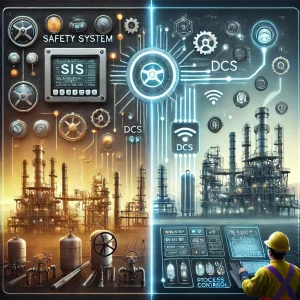The Role of Integrated Safety Instrumented Systems in Process Safety
Introduction In the ever-evolving landscape of industrial automation, ensuring process safety is paramount. The integration of Safety Instrumented Systems (SIS) with process control systems has emerged as a game-changer in enhancing both safety and efficiency. Traditionally, SIS functioned independently from process control systems, but modern advancements are driving a convergence that simplifies operations while maintaining rigorous safety standards.
Understanding Safety Instrumented Systems (SIS) A Safety Instrumented System (SIS) is designed to reduce risk and prevent hazardous events by initiating automated responses in case of process deviations. It comprises sensors, logic solvers, and final control elements that work together to detect abnormal conditions and take corrective actions. SIS is governed by international safety standards such as IEC 61508 and IEC 61511, ensuring robust and standardized safety measures across industries.
The Shift Towards Integrated SIS Historically, SIS operated independently from Distributed Control Systems (DCS) to maintain functional safety and minimize common-cause failures. However, advancements in technology and risk assessment methodologies have paved the way for integrating SIS with process control systems. This integration offers several advantages:
- Enhanced Operational Efficiency – A unified platform streamlines operations by providing a single interface for monitoring both safety and process control parameters.
- Improved Data Analysis and Diagnostics – Integrated systems allow real-time data exchange, enabling predictive maintenance and quicker response to anomalies.
- Reduced Complexity and Cost – Combining SIS and DCS on a common platform reduces the need for separate hardware, lowering capital and operational expenses.
- Better Compliance with Safety Standards – Modern integrated systems are designed to adhere to strict safety regulations while optimizing performance.
Key Considerations for Integration While the benefits of integration are compelling, certain challenges must be addressed to ensure safe and reliable implementation:
- Cybersecurity Concerns: Integrating SIS with process control systems increases exposure to cyber threats, necessitating robust security measures.
- Functional Independence: Even in an integrated setup, SIS must maintain functional independence to prevent cascading failures.
- System Validation and Testing: Rigorous validation and periodic testing are essential to verify that safety functions perform as intended.
Industry Applications of Integrated SIS Industries such as oil and gas, chemical processing, power generation, and pharmaceuticals have adopted integrated SIS solutions to enhance safety and operational efficiency. For example, in refineries, integrated SIS helps in managing high-risk processes such as pressure relief, emergency shutdowns, and leak detection.
Future Trends in SIS Integration The future of SIS integration is poised for further advancements with emerging technologies such as:
- Artificial Intelligence (AI) and Machine Learning (ML): Predictive analytics can enhance fault detection and preventive maintenance.
- Cloud-Based Safety Monitoring: Remote monitoring of safety parameters enables proactive risk management.
- IoT-Enabled Safety Devices: Smart sensors can improve real-time hazard detection and response mechanisms.
Conclusion The integration of Safety Instrumented Systems with process control systems is revolutionizing process safety by offering a balance between efficiency and risk mitigation. As industries continue to embrace digital transformation, the adoption of integrated SIS will play a crucial role in ensuring safer, smarter, and more sustainable industrial operations.
YouTube Official Channel: Discover what’s new & trending globally on YouTube’s official channel. Watch must-see videos, from music to culture & internet phenomena.
LinkedIn Company Page: Visit the LinkedIn Company Page to learn more about the company, its employees, industry insights, and updates.



